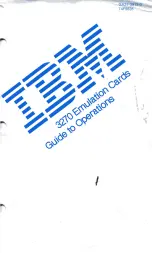
— 7 —
AES Digital Output (Digital Input):
>130dB at 0dBFS
Program Signal Latency
3.6 milliseconds for composite/MPX;
4.2 milliseconds from any input to
any output in any operating mode.
19kHz Stereo Pilot Protection:
>65dB referred to 9% pilot injection.
38kHz Suppression:
>80dB referred to full carrier modula-
tion.
57kHz RDS Subcarrier Protection:
>65dB referred to 5% RDS subcarrier in-
jection.
REAR-PANEL APPOINTMENTS
Digital Line Input:
The AES3 stereo input (XLR) accepts 16-
or 24-bit program sources at sampling
rates of 32kHz, 44.1kHz, 48kHz and
96kHz. Input gain is adjustable for av-
erage program levels between –5dBFS
and –35dBFS. (Page 12)
Analog Line Inputs:
L/R active balanced/bridging (XLR) in-
puts accept average program line levels
between –15dBu and +15dBu. +26dBu
peak input level. (Pages 12, 19)
Digital Line Output:
The AES3 (XLR) 24-bit stereo output
may be adjusted between –20dBFS and
0dBFS, corresponding to full carrier
modulation. The output sampling rate
may be set to follow the Digital Line
Input or forced to 32kHz, 44.1kHz,
48kHz or 96kHz. (Pages 13, 37)
Analog Line Outputs:
Active balanced (XLR) outputs are ad-
justable between –10dBu and +24dBu
(+21.5dBm), corresponding to full car-
rier modulation; source impedance is
200 ohms. (Pages 13, 37)
Line Output Characteristics:
The Digital and Analog Line Outputs
may each be configured independently
for 20kHz flat response, or for 15kHz
‘FM’ characteristics, either with pre-
emphasis or normalized to flat. (Pages
13, 38)
Composite/MPX Output:
Two unbalanced (BNC) outputs are in-
dependently adjustable between 0.8V
p-p and 9V p-p (+12dBu), correspond-
ing to 100% carrier modulation; source
impedance is 75 ohms. Pre-emphasis
may be set to 75µs, 50µs or OFF. (Pag-
es 13, 40)
RDS Input:
Unbalanced/bridging (BNC) input ac-
cepts a 57kHz RDS subcarrier at any
level between 0.5V p-p and 5.0V p-p for
a typical injection level of 5% of total
carrier modulation. (Pages 14, 41)
19kHz RDS Sync:
When RDS is enabled, the Sync Output
(BNC) delivers a 5V p-p TTL-compatible
square wave at the 19kHz pilot fre-
quency; 75-ohm source. (Page 14)
Network Port:
An RJ45 jack accepts TCP/IP network
connections for remote setup and op-
eration of the DAVID IV. (Page 47)
Headphone Jack (Front Panel):
A quarter-inch (TRS) headphone jack al-
lows the user to monitor the processed
program audio. A volume control next
to the jack adjusts the listening level.
AUDIO PROCESSING FEATURES
Program High-Pass:
A user-programmable high-pass filter
attenuates sub-audible noise that could
compromise modulation efficiency.
The filter is adjustable between 20Hz
and 65Hz. (Page 21)
AGC:
Unobtrusive, ‘windowed’ AGC is both
peak- and average-responding with a
capture/correction range of ±18dB.
Positive AGC gain may be truncated to
any value b18dB and 0dB. The
AGC window and correction rate are
user-programmable. (Page 22)
Stereo Enhancement:
This dual-action utility effectively
broadens the soundstage for the stereo
program and the center-channel ‘solo’
component independently. (Page 23)
5-Band ‘Multipressor’:
Program audio is split into five fre-
quency bands. Each user-adjustable
band imparts parameter-programmable
dynamic compression and adjustable
static gain to afford both static and dy-
namic equalization ‘signature’ control
over the program audio. (Page 24)
Bass Augmentation:
Sub-bass program frequencies undergo
independent dynamic compression, ex-
pansion, selective clipping and filtering
for control over both static ‘Rumble’
and dynamic ‘Punch’ of bottom-end
components. (Page 29)
Summary of Contents for 719
Page 1: ...DAVID IV FM Audio Broadcast Processor Installation User Guide www inovonicsbroadcast com ...
Page 2: ......
Page 4: ......
Page 70: ... 66 NOTES AND DOODLES ...












































